It‘s super easy to make authentic and homemade Japanese Miso Soup! In this recipe, I show you how to make quick and easy soup stock (dashi) from scratch, then create classic miso soup with tofu and wakame seaweed. It‘s delicious and has many health benefits.
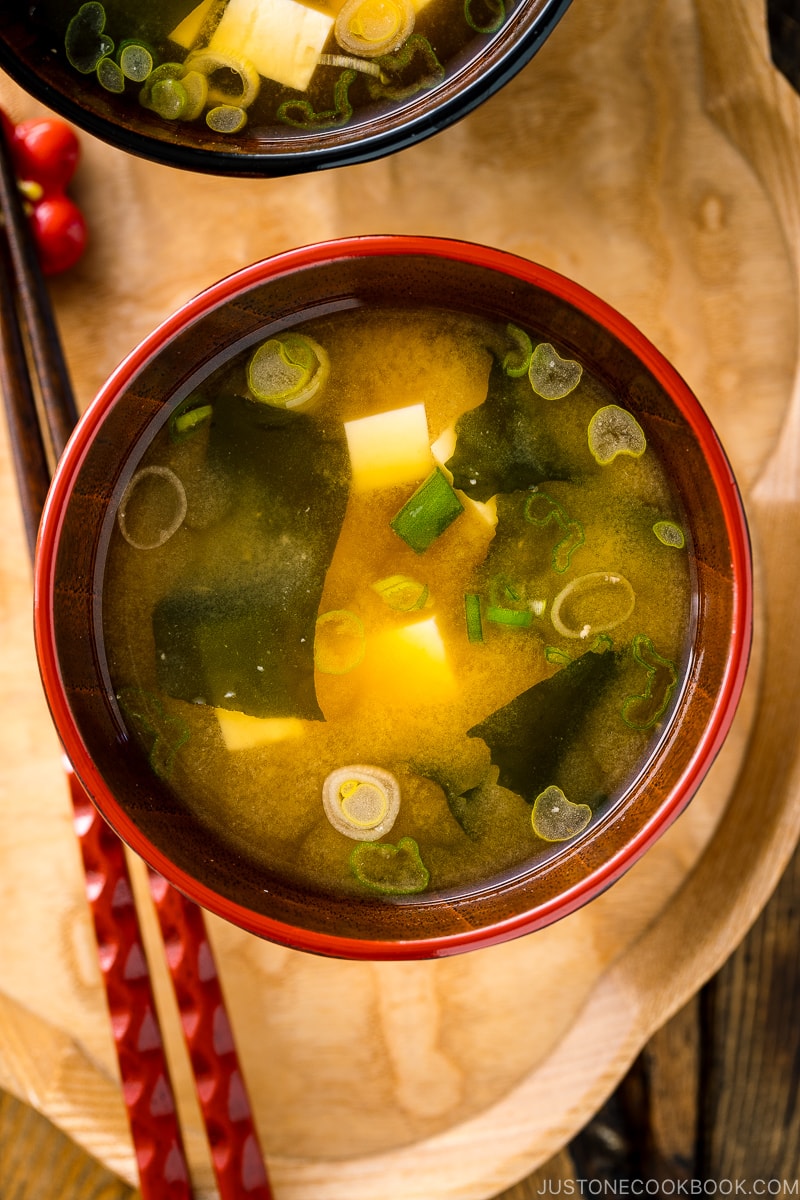
Miso soup is one of those simple joys in life—comforting, nourishing, and incredibly easy to make. We enjoy it daily for breakfast, lunch, or dinner.
Once you master the basics, you can customize it to your taste. This guide will show you how to make authentic miso soup at home—better than any restaurant or instant version!
If you love miso soups, try my Tonjiru, Kabocha Miso Soup, and Kenchinjiru recipes next!

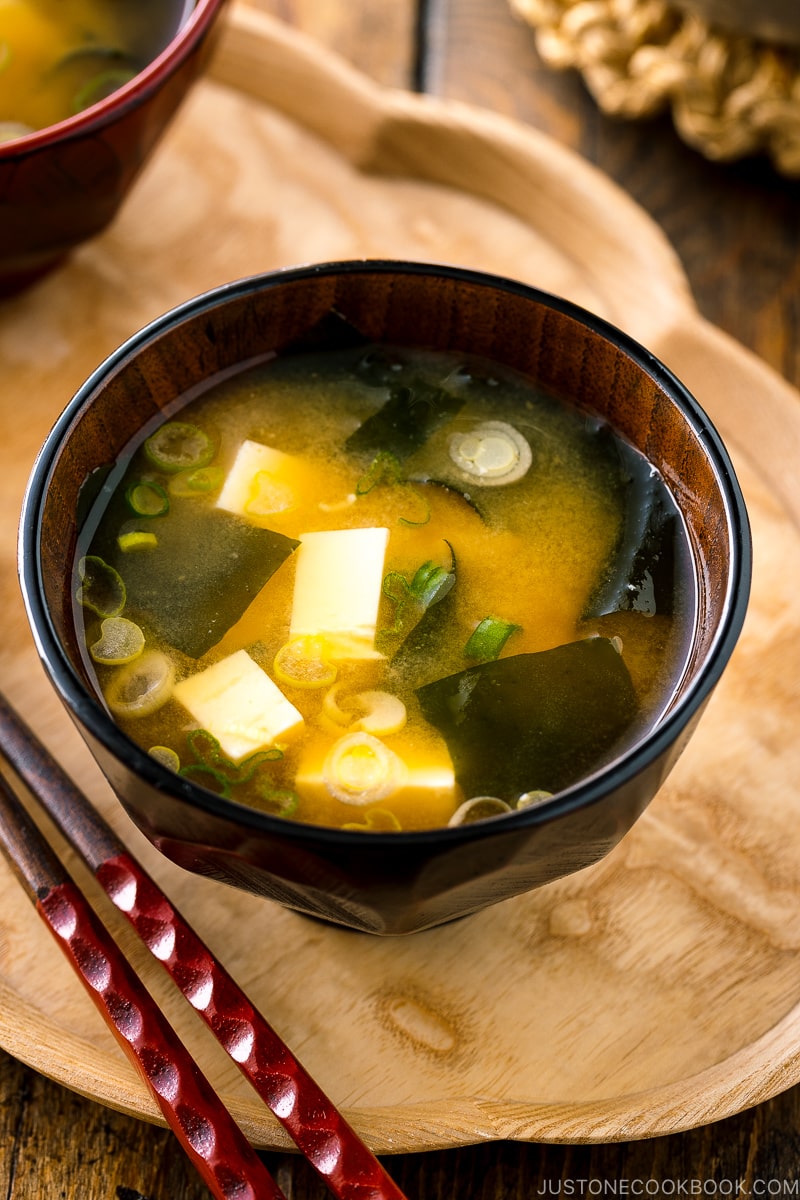
What is Miso Soup?
Miso soup (味噌汁, miso shiru) is a traditional Japanese soup made from a miso paste mixed into dashi (Japanese soup stock). It often includes ingredients like tofu, seaweed, green onions, and vegetables, with variations depending on the region and season. A staple in Japanese cuisine, miso soup is enjoyed as a side dish with meals, offering a comforting umami flavor and numerous health benefits.
If you are already familiar with making miso soup, check out my Seasonal Miso Soup Recipe Collection.
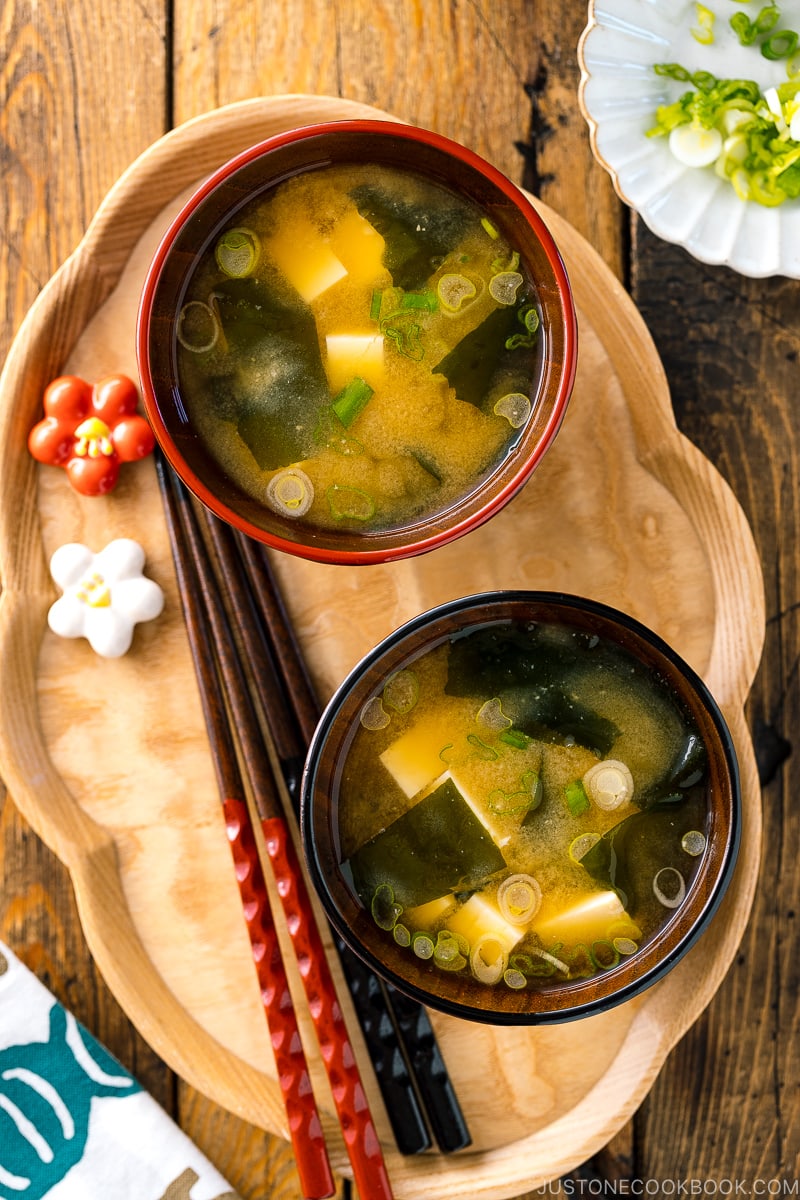
Basic Ingredients You’ll Need
Let’s master the classic version with tofu and wakame seaweed. The ingredients include:
- Dashi (Japanese soup stock) — The heart of authentic miso soup. We’ll dive into it below!
- Miso paste
- Tofu (silken or medium-firm, cut into cubes)
- Dried wakame seaweed
- Green onions (chopped)
3 Simple Steps to Make Miso Soup
Making miso soup is easy when you break it down into three simple steps:
- Make dashi (Japanese soup stock) – 20 minutes
- Add miso – 2 minutes
- Add tofu and wakame, then serve – 3 minutes
Once you’ve mastered this basic recipe, you can easily customize your miso soup with different ingredients for endless variations.
Step 1: Make Dashi
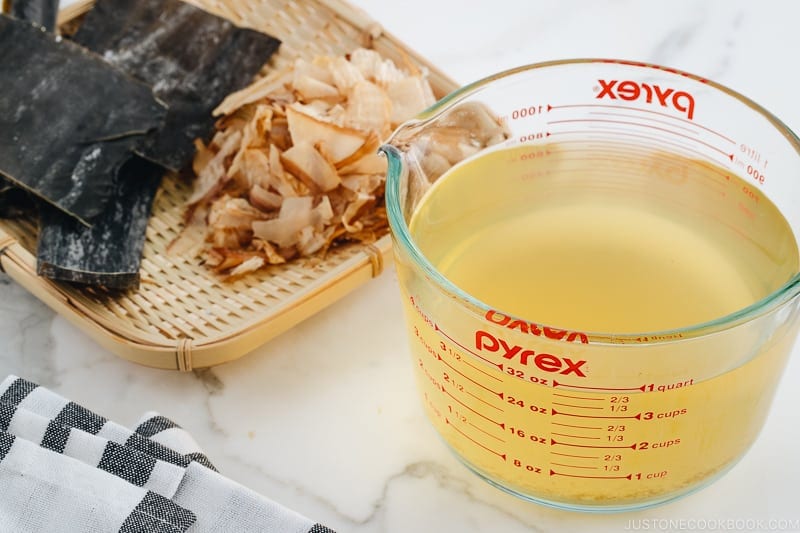
What is Dashi?
Dashi (だし, 出汁) is a fundamental Japanese soup stock and the backbone of many Japanese dishes. It’s incredibly quick and easy to prepare, making it an essential component of authentic miso soup. Unlike chicken or vegetable stock, dashi provides the signature umami flavor that defines true Japanese cuisine—without it, it’s simply not miso soup.
- Awase Dashi — This is the most common dashi made from kombu (kelp) and katsuobushi (dried bonito flakes).
- Kombu Dashi — This dashi is made solely from kombu (kelp). It’s plant-based.
- Vegan Dashi — This dashi combines kombu and dried shiitake mushrooms for a rich, umami-packed broth.
- Iriko Dashi — This dashi uses dried anchovies for a deeper, briny flavor. It’s a popular choice for miso soup in Japan.
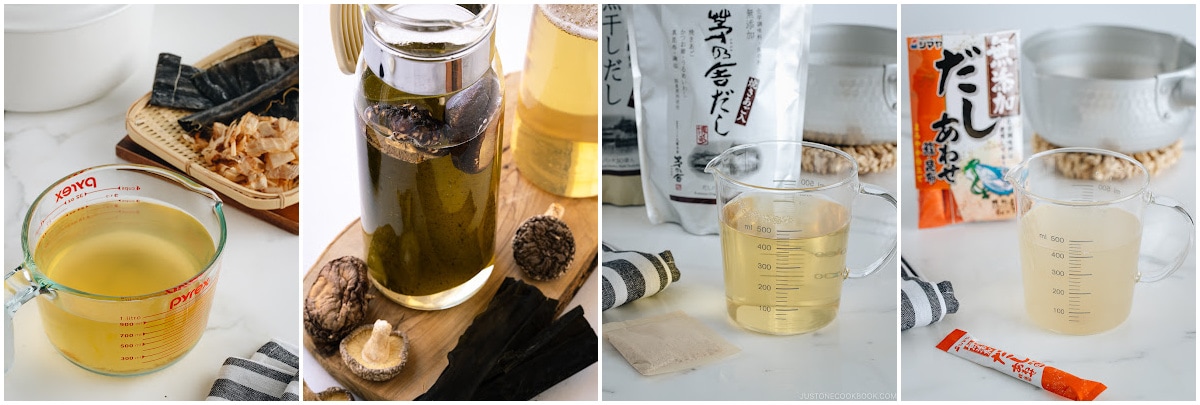
There are three main ways to make dashi, each with its own balance of flavor and convenience.
- Homemade dashi (best flavor & quality) —To make Awase Dashi, simply soak kombu in cold water, heat it just below boiling, then add bonito flakes and let it steep briefly before straining. For Kombu Dashi or Vegan Dashi, a cold brew method works best—just soak the kombu in the water ahead of time for a naturally deep flavor before steeping briefly.
- Dashi packet (best shortcut) — A dashi packet is my go-to shortcut when I’m short on time. Just like brewing tea, you steep the packet in hot water for a couple of minutes, and you’re left with a flavorful broth that’s surprisingly close to homemade.
- Dashi powder (fastest, but least flavorful) — Dashi powder (or granules) is the quickest method—just dissolve it in hot water, and you’re done. While convenient, the flavor tends to be weaker and fades quickly, so I only use this when I have no other options.
Pro Tip: Dashi is a staple in Japanese cooking, adding a deep umami flavor to many dishes. Make a big batch and store it in the refrigerator for 3–5 days or freeze it for up to two weeks. With dashi ready to go, you can whip up a comforting bowl of miso soup in under 5 minutes!
Step 2: Add Miso Paste
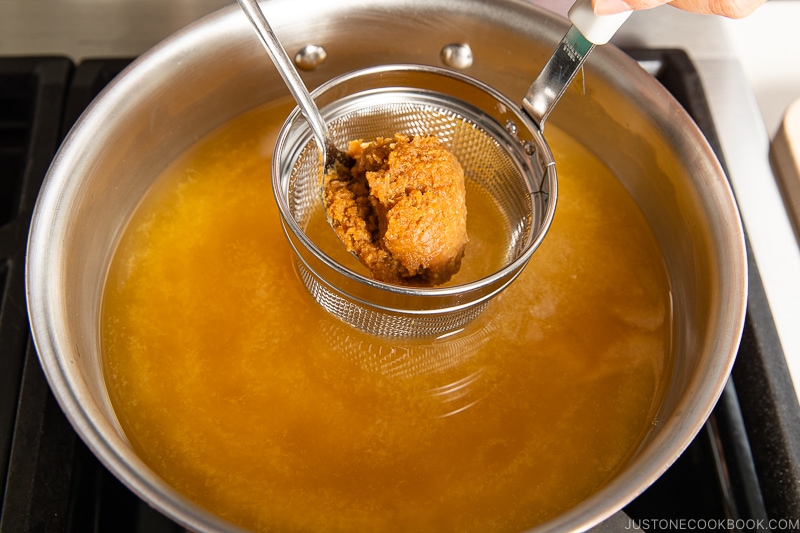
What is Miso?
Miso (味噌) or fermented soybean paste is made from soybeans, grains (steamed rice or barley), salt, and koji culture (麹, a fermentation starter).
There are many types of miso available, each with its own unique flavor. In the U.S., grocery stores typically categorize miso by color: white miso (shiro miso) for a mild, slightly sweet taste, red miso (aka miso) for a deeper, bolder flavor, and yellow miso (awase miso or mixed miso) as a balanced option. Want to dive deeper? Check out our detailed guide on miso!
Miso varies in saltiness and flavor, so there’s no “right” miso for miso soup. Adjust the amount to taste, or blend two or three types for more complexity. If you have a high-quality miso, enjoy its unique flavor on its own!
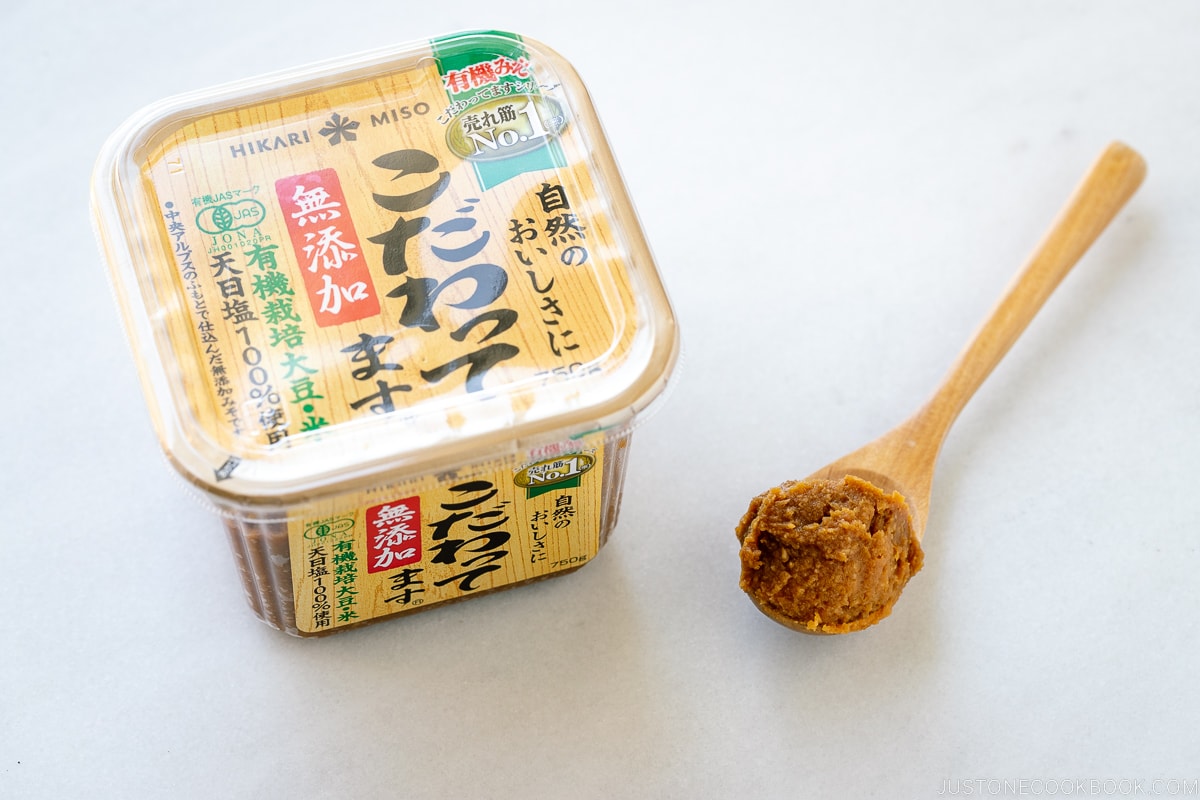
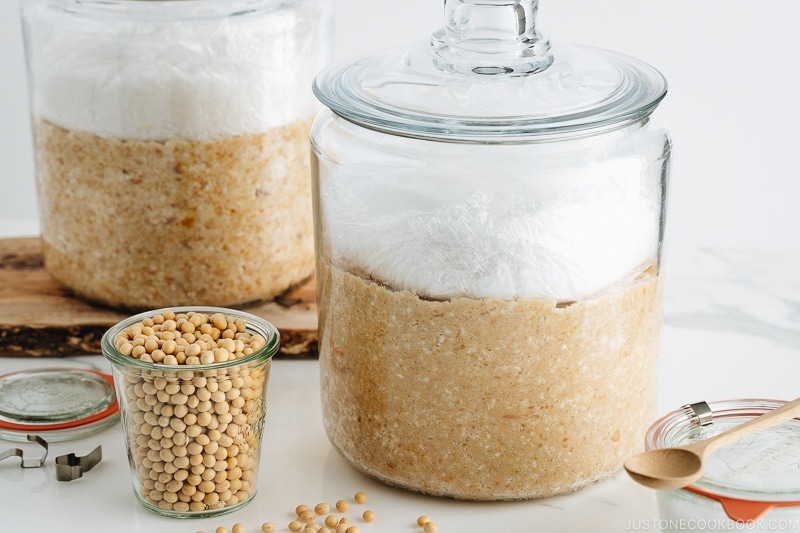
- My favorite miso is this Kodawattemasu from Hikari Miso (organic slow-aged red koji miso). It has a more rounded character that goes well with any ingredients.
- If you want to make miso from scratch, check out my How to Make Homemade Miso post.
- Dashi-included miso (だし入り味噌) may be convenient, but it lacks the health benefits of fresh miso. Manufacturers add additives and sterilize them to preserve quality, which stops the action of beneficial yeasts. For better taste and health benefits, it’s best to use traditional miso and prepare your own dashi.
How Much Miso Paste to Add to the Soup?
- In Japan, the general rule of thumb is to add one tablespoon (18 g) of miso paste per miso soup bowl (200 ml).
When you add miso paste, make sure to turn off the heat before adding miso paste to avoid accidentally boiling the soup.
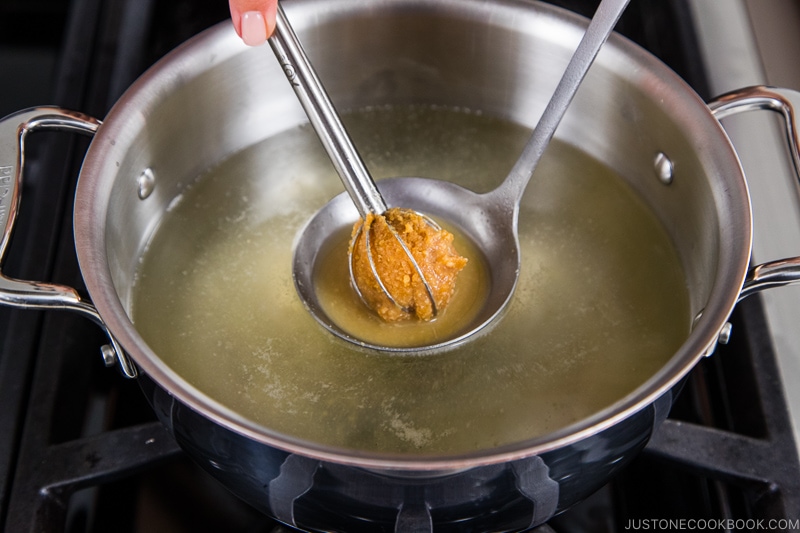
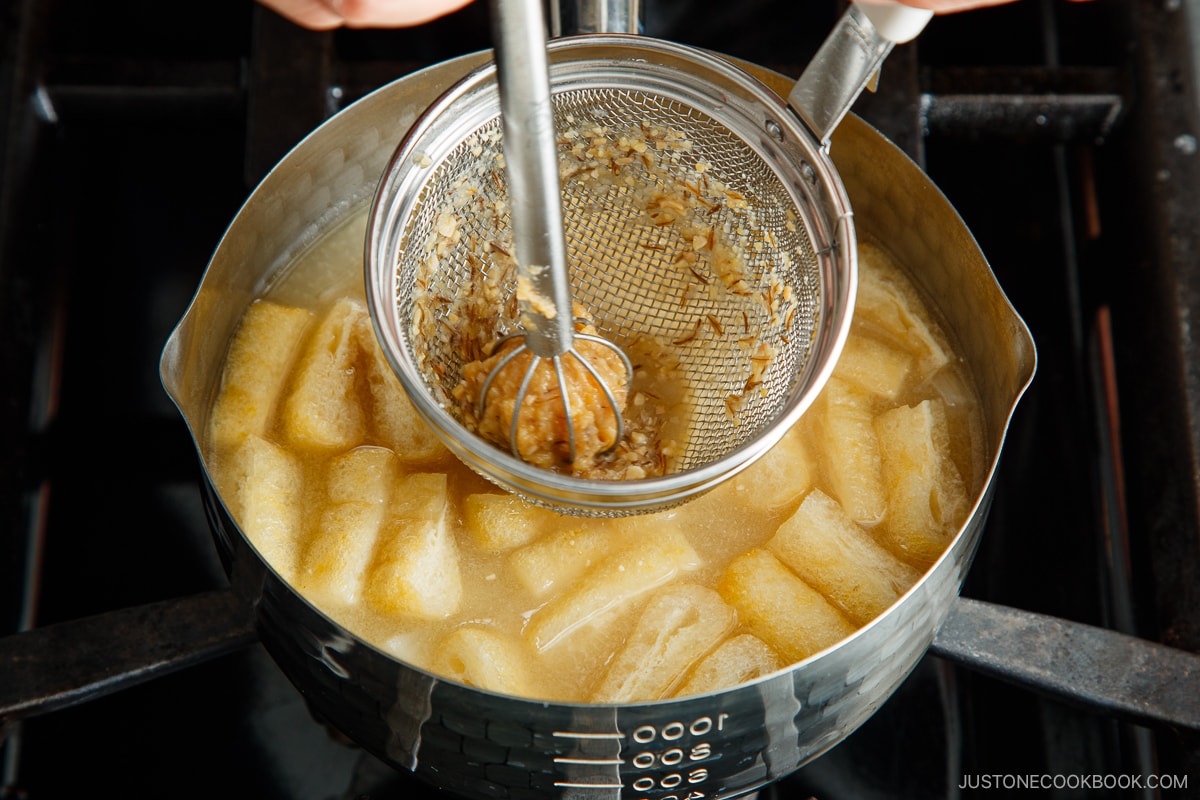
Always dissolve the miso paste first in a ladle or separate bowl—never add it directly to the soup. Other kitchen tools I like:
- Miso Muddler (my favorite) – one side measures 2 Tbsp and the other 1 Tbsp to help dissolve miso.
- Fine-mesh strainer – to ensure smooth miso without clumps.
When Do You Add Miso Paste?
- Add miso paste to dashi right before serving to preserve its best flavor and aroma. Miso will lose its fragrance if reheated multiple times.
- Before adding the miso, bring the dashi to a slow boil, around 205°F (96°C). This is an ideal temperature for releasing the most fragrant notes of the miso soup. By the time you’re ready to enjoy it, the soup will be at a perfect drinking temperature of 167°F (75°C).
Step 3: Add Tofu to the Soup
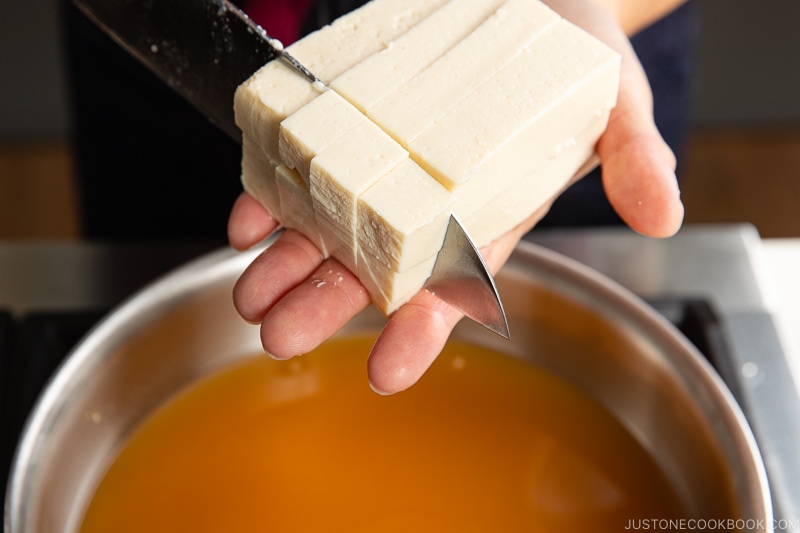
To avoid breaking the tofu, always add it after dissolving the miso paste. This helps keep the tofu intact and ensures a smoother texture in your soup. Since tofu doesn’t require cooking, you just need to warm it up.
- Silken or medium tofu? In Japan, silken tofu (kinugoshi tofu 絹ごし豆腐) is slightly more popular than medium tofu (momen tofu 木綿豆腐), but both tofu are common in miso soup. Silken tofu adds a custardy texture while medium tofu is spongier.
- In Japan, it’s common to cut tofu on your palm, as seen in dramas and anime. If you’re new to it, use a cutting board for safety. For miso soup, cut tofu into ½-inch (1.3 cm) cubes.
Along with tofu, add dried wakame and green onions at the same time.
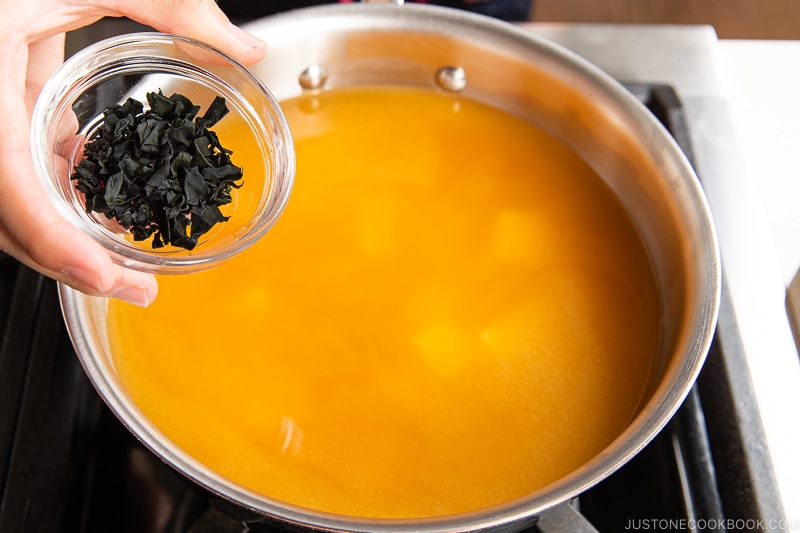
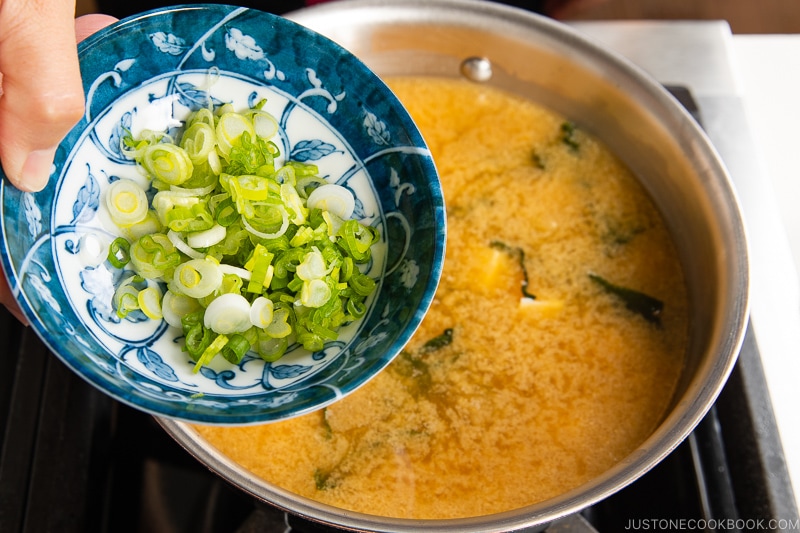
Serve miso soup immediately while it’s warm. By the time you are ready to enjoy it, the soup will be at a perfect drinking temperature of 167°F (75°C).
Reheating Miso Soup
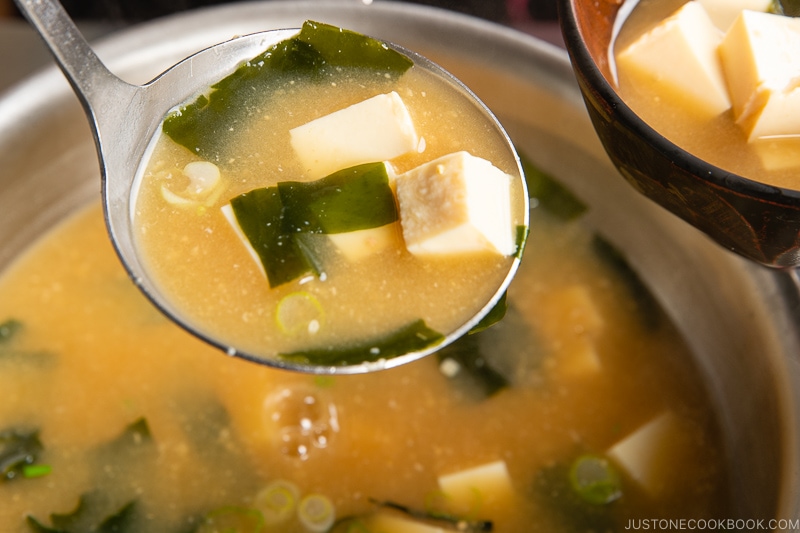
If your miso soup cools down, gently reheat it to a simmer (around 190°F/88°C), but never let it boil. Boiling diminishes its delicate flavor and aroma.
When reheating leftover miso soup, stir in about 1 tablespoon (18 g) of miso to refresh its aroma. Adjust the consistency by adding more dashi or water if needed.
Care About Miso’s Probiotics?
A common misconception is that boiling miso soup destroys its probiotics. In reality, probiotics die at temperatures above 140°F (60°C), but the main reason to avoid boiling is to preserve miso’s delicate flavor and aroma.
In Japan, miso soup is valued not just for probiotics but also for its protein, fiber, and minerals, which remain intact despite heat. To maximize probiotics, use miso in salad dressings, dips, or sauces instead.
How to Store Miso Soup
While it’s best to enjoy miso soup right away for the freshest taste and aroma, leftovers can be stored with a few precautions:
- Let miso soup cool to room temperature (within 4 hours; longer could cause spoilage) before refrigerating. You can store it in the refrigerator for up to 3–4 days.
- Miso soup can also be frozen for up to 2 weeks, but be sure to remove tofu before freezing, as its texture will change upon reheating.
- For reheating, follow the tips mentioned earlier.
Tips for Making a Big Batch
To store miso soup for later use, it’s best to refrigerate the soup without adding the miso. When you’re ready to serve, simply add the miso paste to the portion you plan to consume. This helps preserve the soup’s freshness and flavor.

How to Add More Ingredients
This is a bit more advanced topic, but I’d like to give a quick introduction to it here.
- If you’re using root vegetables, place them in cold dashi and cook until they become tender, approximately 10-15 minutes, depending on the vegetable’s density and cut sizes.
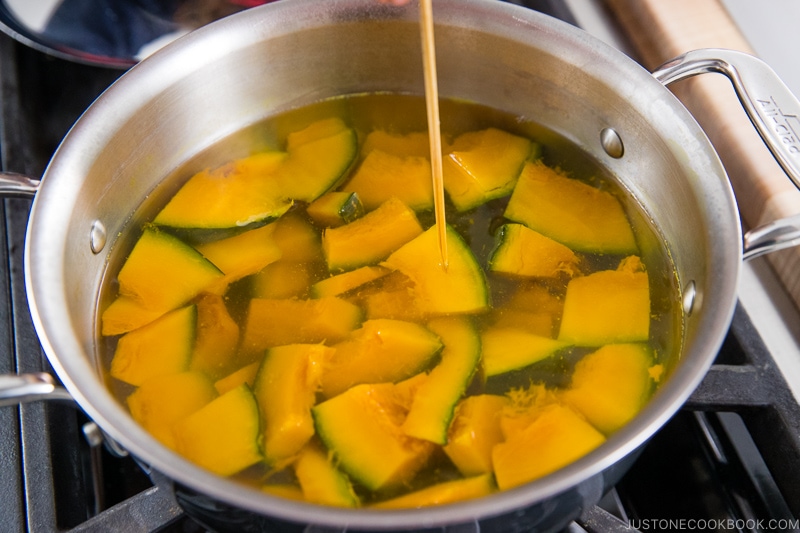
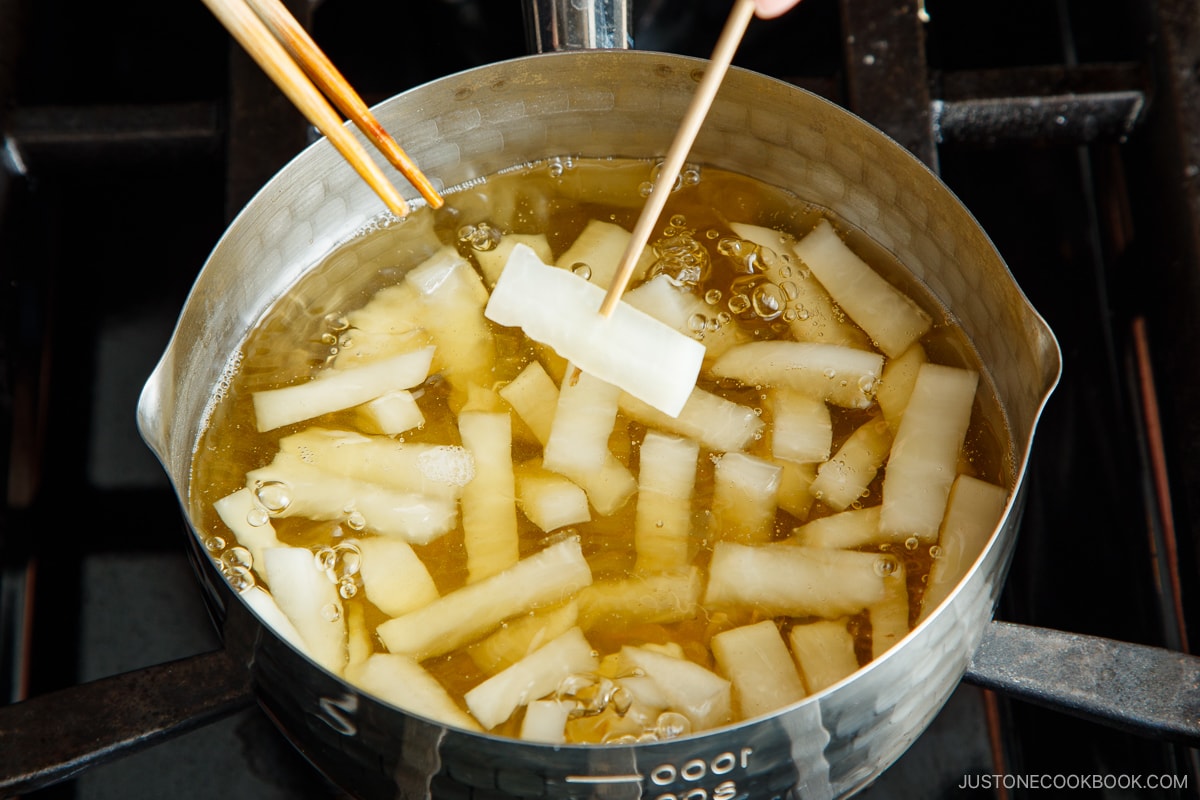
- For leafy vegetables and mushrooms, add them to simmering dashi (with or without other cooked ingredients) and cook for a few minutes.
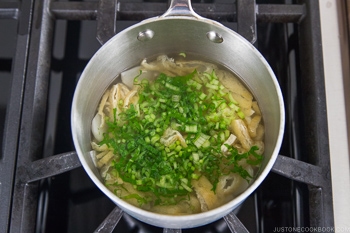
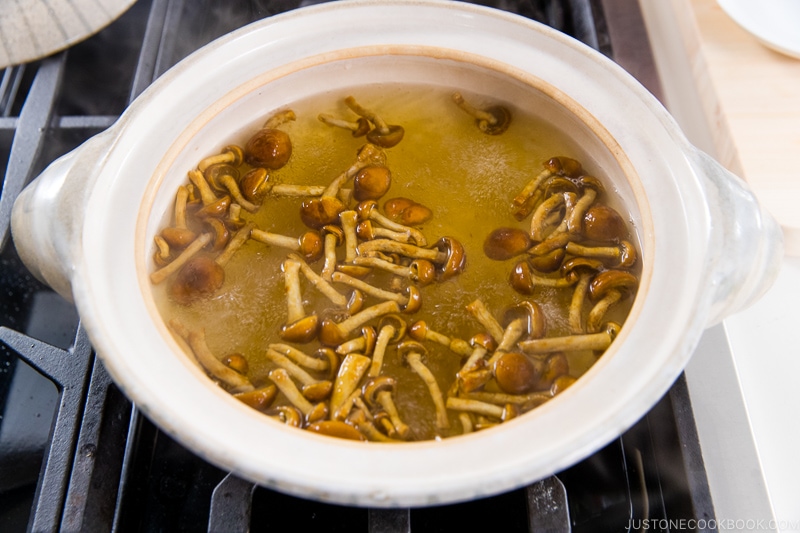
- For miso soup with seasonal ingredients, check out my Just One Cookbook Miso Soup Recipes.
Health Benefits of Miso Soup
I drink miso soup daily, as I believe it’s a delicious and healing gateway to excellent health. Much like green tea, I’d say miso soup is the elixir of the Japanese diet. Here are just a few health benefits I’ve found from miso soup:
- Good source of nutrients. Miso is rich in essential minerals like copper, manganese, protein, Vitamin K, and zinc. For me, drinking a bowl of miso soup daily is like taking a natural supplement for my health.
- Good for bones. Miso soup provides many bone-building minerals like calcium, magnesium, and manganese, which help reduce the risk of developing osteoporosis.
- Improve heart health. The natural compounds in miso, like Vitamin K2, linoleic acid, and saponin, are known to reduce the risk of heart disease and lower cholesterol.
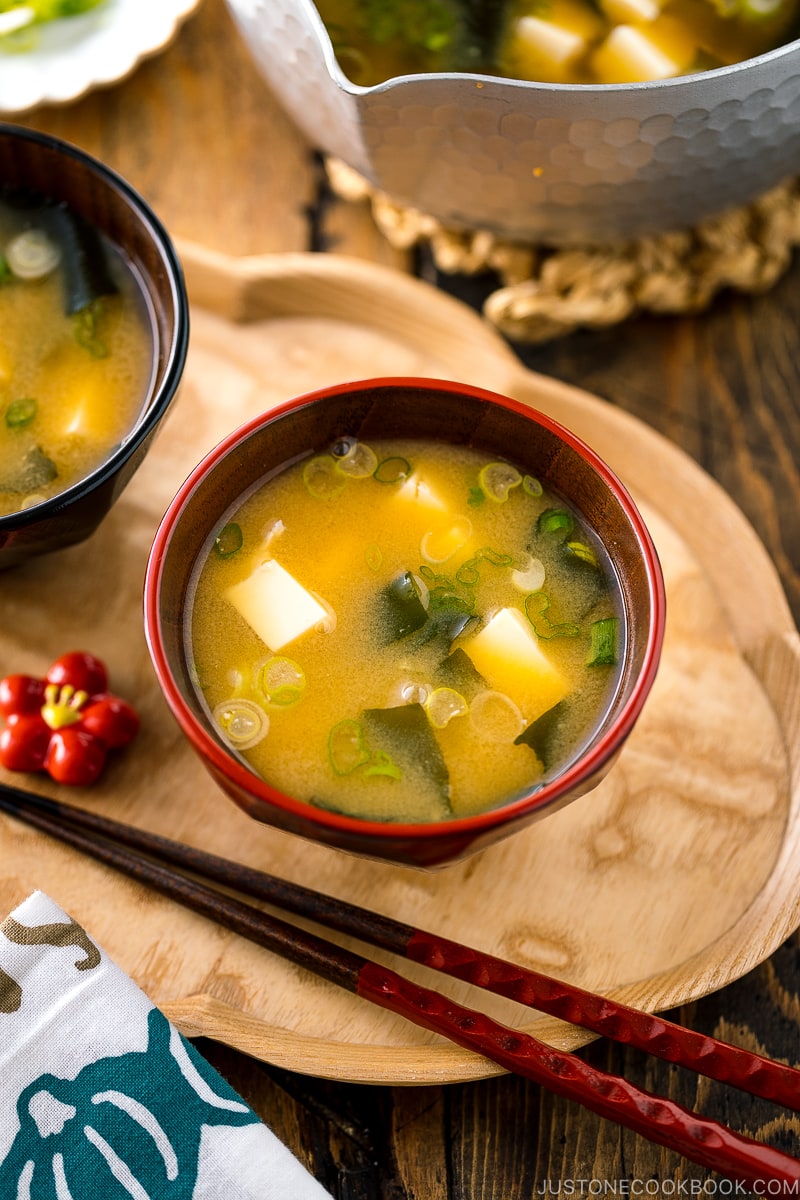
6 Key Takeaways to Remember
- You can make a big batch of dashi and store it in the refrigerator for 3–5 days for convenience.
- Add miso right before serving for the best fragrance and taste!
- Bring dashi to a slow boil (around 205°F/96°C), then turn off the heat before adding miso. This temperature ensures the best aroma and flavor of miso soup. When it’s time to serve, the soup will be at an ideal drinking temperature of 167ºF (75ºC).
- Use 1 tablespoon of miso per 1 miso soup bowl (200ml), and adjust the taste. To avoid clumps, dissolve miso first in a ladle, a separate bowl, or a miso strainer before adding it to the dashi.
- Add tofu, wakame, and green onions after the miso is dissolved.
- Never bring miso soup to a full boil, as this will diminish its flavor and aroma.
Now that you’ve learned how to make miso soup at home, I hope you enjoy this nourishing soup every day!
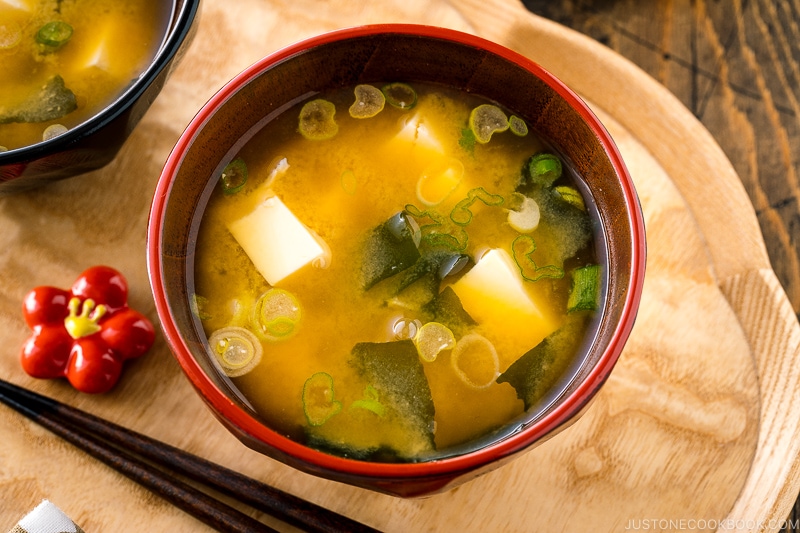

Homemade Miso Soup with Tofu
Video
Ingredients
For the Dashi (makes a scant 4 cups)
- 4 cups water
- 1 piece kombu (dried kelp) (⅓ oz, 10 g per piece; 4 x 4 inches or 10 x 10 cm)
- 1 cup katsuobushi (dried bonito flakes) (packed; I used a loosely packed 3 cups in the video for stronger flavor)
For the Miso Soup
- 7 oz soft/silken tofu (kinugoshi dofu)
- 4 Tbsp miso (use 1 Tbsp, 18 g for every 1 cup, 240 ml of dashi)
- 1 Tbsp dried wakame seaweed
- 1 green onion/scallion
Instructions
- Before we start… I make Awase Dashi with kombu and katsuobushi in this recipe. You can also make dashi with a dashi packet or powder. For vegan/vegetarian, make the Kombu Dashi I showed below or make Vegan Dashi with kombu and dried shiitake mushrooms.

- Gather all the ingredients.
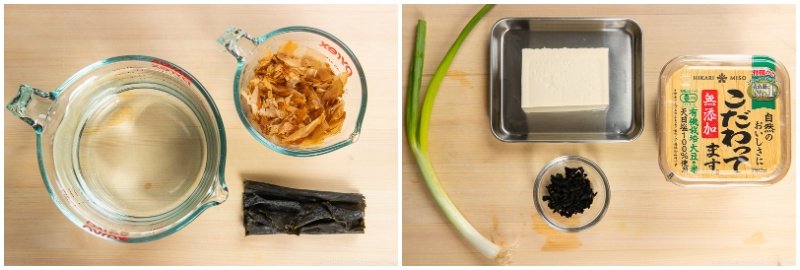
- Cut 1 green onion/scallion into thin rounds.
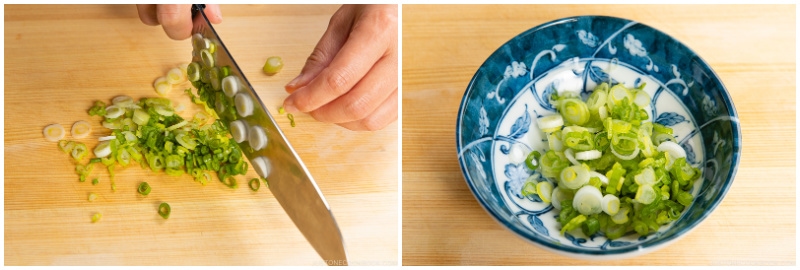
To Make the Dashi (can make in advance)
- Add 4 cups water and 1 piece kombu (dried kelp) to a medium saucepan. If you have time, soak the kombu in water for 30 minutes. NEVER wash kombu and do not remove the white substance—that’s umami! These days, it‘s pretty clean, so just make sure there are no dirt particles.
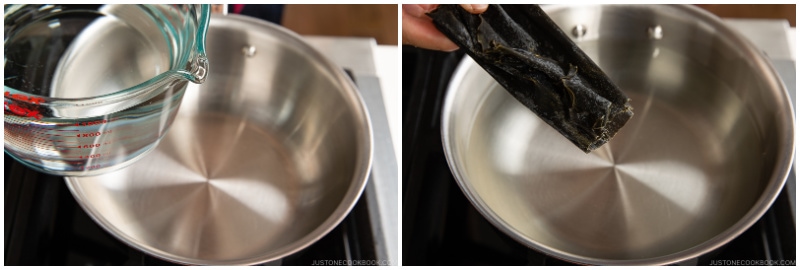
- SLOWLY bring it to a boil (about 10 minutes) on medium-low heat so you can extract as much umami from the kombu as possible. Right before the stock boils, remove the kombu and set it aside for another use. (If you leave the kombu, it gets slimy and yields a bitter taste.) Now, what you have is Kombu Dashi. If you’re vegetarian/vegan, use this kombu dashi for your miso soup.
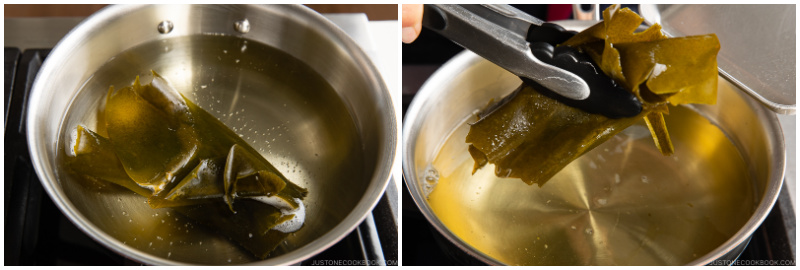
- If you‘re not vegetarian/vegan, add 1 cup katsuobushi (dried bonito flakes) to the kombu dashi and bring it back to a boil again. Once the dashi is boiling, reduce the heat, simmer for just 30 seconds.
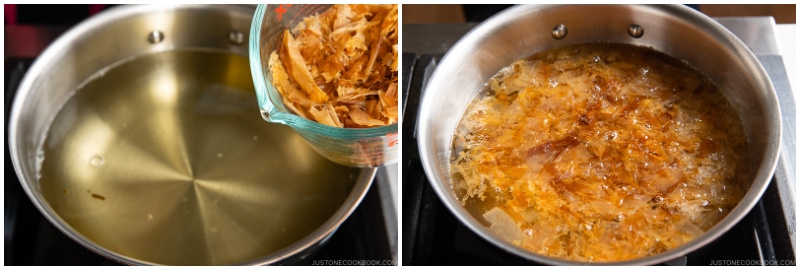
- Turn off the heat and let the katsuobushi sink to the bottom, about 10 minutes. Then, strain through a fine-mesh sieve.
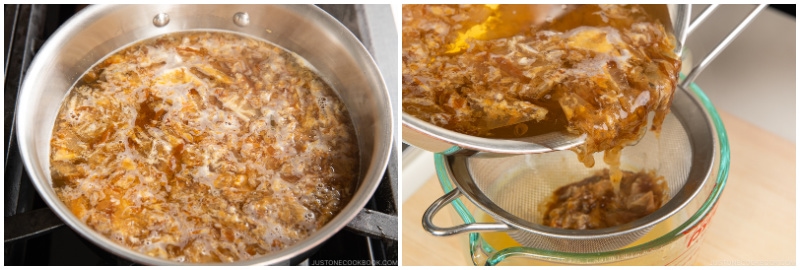
- Now you have roughly 4 cups of Awase Dashi. You can store the dashi in the refrigerator for up to 3–5 days and in the freezer for up to 2 weeks. Reserve the spent katsuobushi and repurpose it; see the suggested recipes that follow at the end of the instructions.
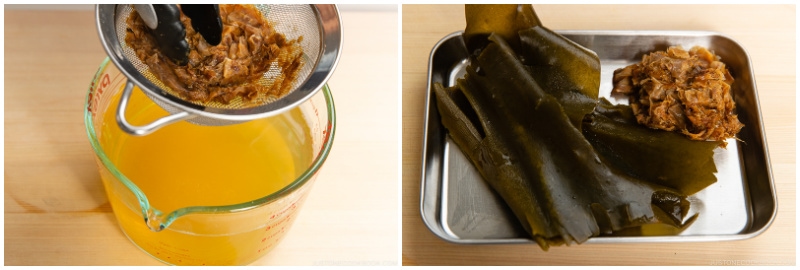
To Make the Miso Soup
- Add the dashi to the saucepan. If you are using dashi from the refrigerator, bring it to a slow boil (205°F/96°C) over medium heat and turn off the heat.
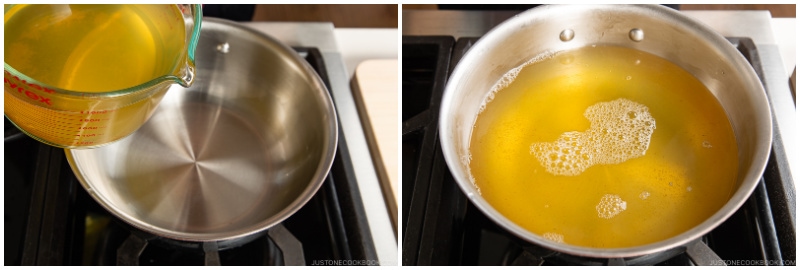
- Add 4 Tbsp miso. Put the miso in a ladle, slowly add the dashi into the ladle, and stir with chopsticks to dissolve completely. Here, I‘m using a miso muddler. If you accidentally add too much miso, dilute the miso soup with dashi (or water).
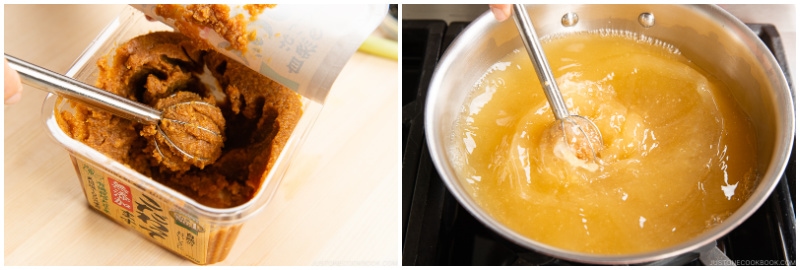
- Here, I‘m using a fine-mesh miso strainer, which helps you dissolve the miso faster. After dissolving the miso in the strainer, you may see rice koji (especially when it‘s koji miso). It‘s up to you if you want to include it in the miso soup or discard it (personal preference).
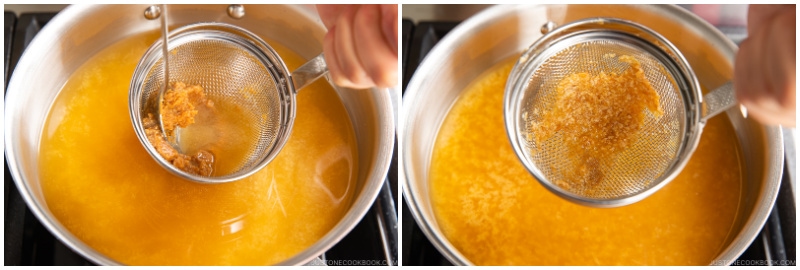
- Cut 7 oz soft/silken tofu (kinugoshi dofu) into ½-inch (1.3 cm) cubes and add to the miso soup. Tip: Add the tofu after the miso is completely dissolved; otherwise, you might break the tofu when stirring in the miso. Note: It is very common to cut tofu on your palm in Japan. However, I recommend using a cutting board if you have never done this.
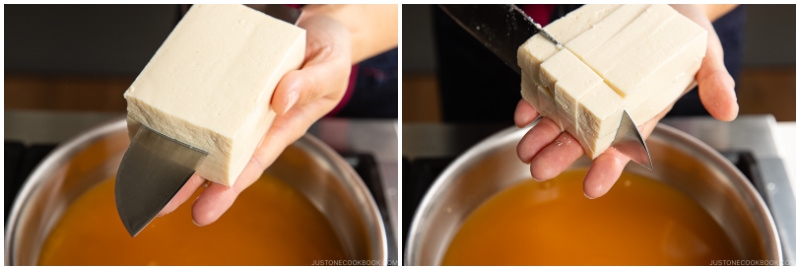
- Add 1 Tbsp dried wakame seaweed and the chopped green onions to the pot right before serving to keep their fresh fragrance and color. Tip: If you worry about salt intake, I recommend rehydrating the dried wakame in a separate bowl of water to get rid of the saltiness, instead of rehydrating it in the soup itself. If reheating, warm up the miso soup until it is just hot. NEVER BOIL miso soup because it loses flavor and aroma.
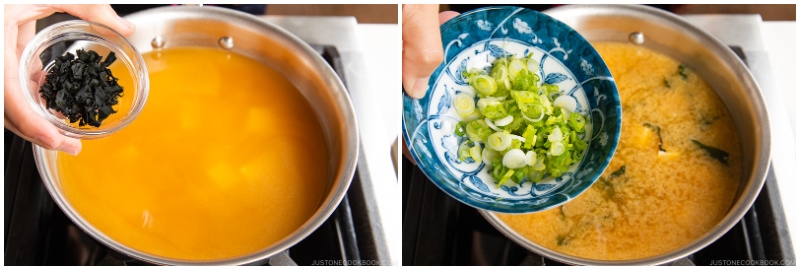
To Serve
- Serve immediately. Place on the right side of the table setting; you can read about this in my post Ichiju Sansai (One Soup Three Dishes).
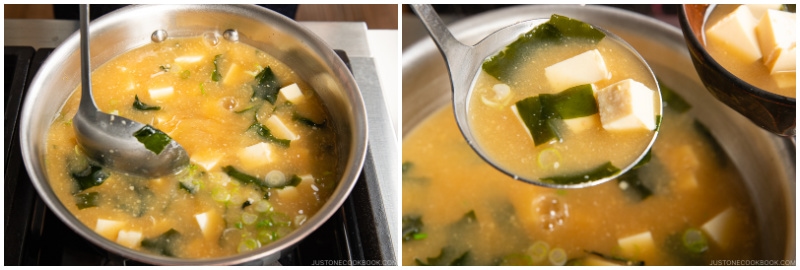
To Store
- In general, it‘s best to consume all the miso soup right away because it will lose its aroma and taste as time passes. Let your miso soup cool to room temperature (up to 4 hours; any longer and it will spoil) and then refrigerate. Keep for up to 2 days in the refrigerator. If you want to make a big batch to store for later, it‘s best to refrigerate the soup without adding the miso. When ready to use, add the miso only for the portion you need. You can freeze miso soup for up to 2 weeks. However, you have to remove the tofu before freezing as the texture will change.
To Reheat the Miso Soup
- Heat the miso soup in a pot over medium heat, but do not boil. Miso loses its nutrients, flavor, and aroma at high temperatures.
What to do with the spent katsuobushi and kombu?
- Save the spent kombu and katsuobushi in an airtight container and store it in the refrigerator for a week or in the freezer for up to a month.
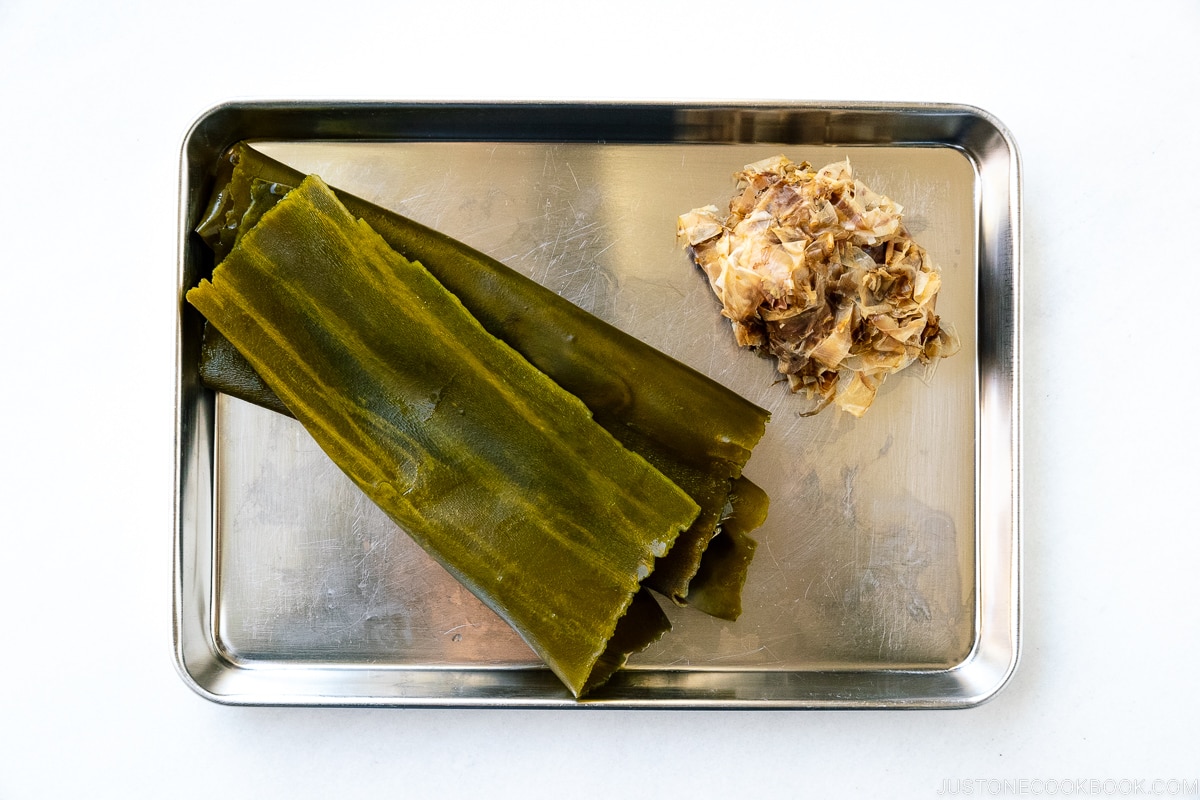
- With the spent kombu, you can make Simmered Kombu (Kombu Tsukudani).
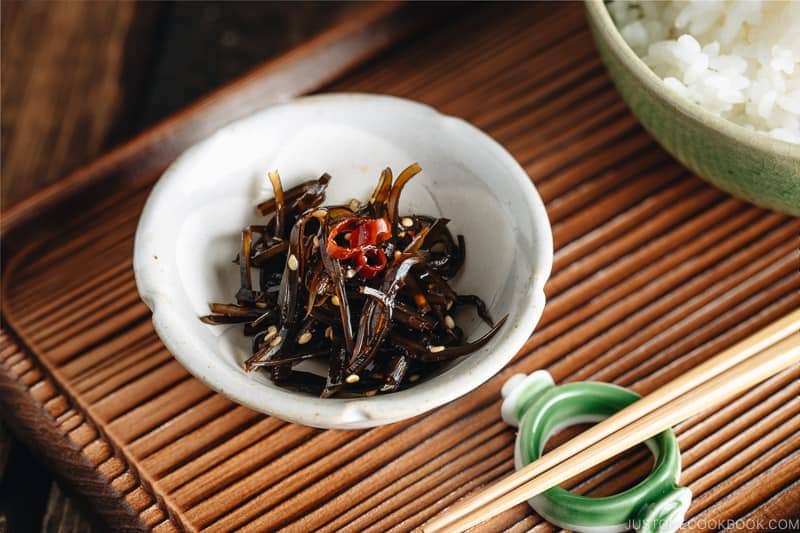
- You can also make Homemade Furikake (Rice Seasoning).
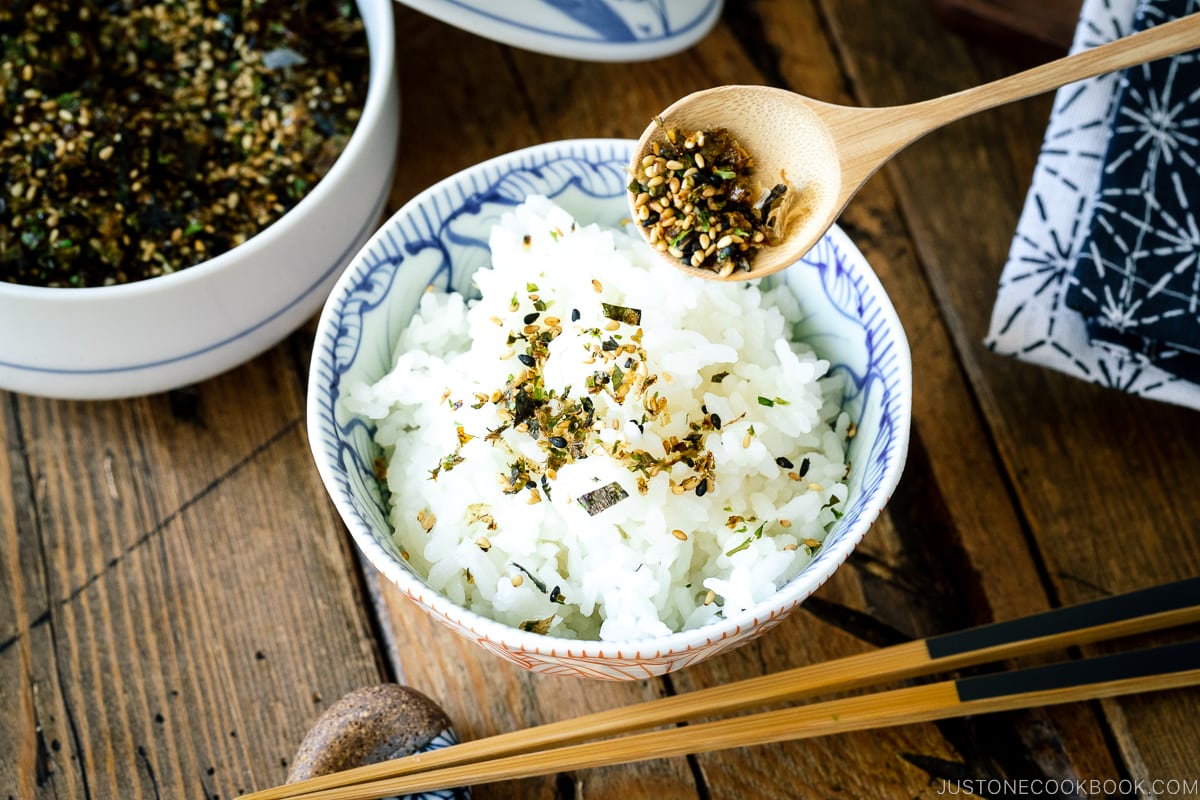
Nutrition
Editor’s Note: The post was originally published on Mar 3, 2011. The recipe was revised and updated on June 7, 2022. The post was updated with new images, a new video, and more helpful content on February 2, 2024.

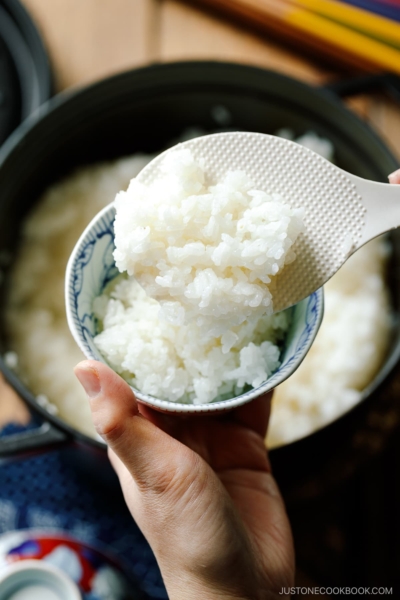

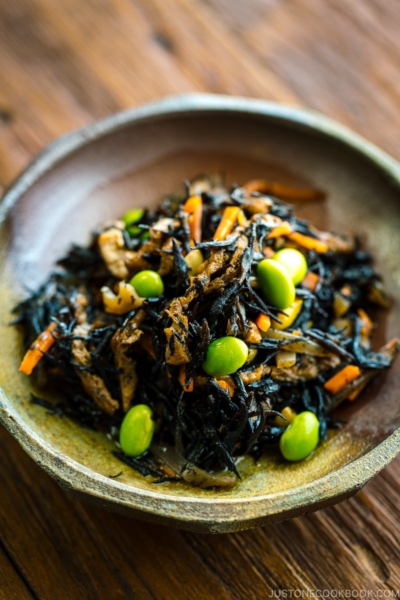





I have read not to cook vegetables in the same dashi as used for the soup as it concentrates the dashi too much. Could you please advise? Thankyou.
Hello Amanda! Thank you for reading Nami’s post!
We believe it depends on the type of dish. For example, if you’re making a dashi-based soup like osumashi, we don’t recommend cooking the vegetables in the dashi for too long, as it can affect the clarity and delicate flavor. Hope that makes sense!
You can read more here:
https://www.justonecookbook.com/japanese-clear-soup
Thank you for this complete miso soup introduction and recipe. One question: the soup appears to have a relatively high salt content. Since tofu has no significant sodium, which ingredient introduces all the salt – and is there a low-sodium alternative?
Hello Craig! Thank you for trying Nami’s recipe!
Miso has a high sodium content, so you can use less Miso and make stronger Dashi for more Umami, or use low-sodium Miso. We hope this helps!
Wow! A great recipe post with lots of helpful photos and tips. I enjoyed the backstory and hearing about the nuances to cooking this seemingly “simple” dish. Looking forward to exploring the rest of your site!
Hello Tom! Thank you very much for your kind words.
We are so happy to hear you enjoyed reading Nami’s post. We hope you discover many delicious recipes from our site. Happy Cooking! 🤗
Excellent recipe! I’ve made this twice using the instructions for the Awase Dashi. First time I made it, the recipe yielded 3 cups of dashi, so the second time I used a little more kombu and added an extra cup of water. I also let it soak for a few hours before starting the cooking process. It’s amazingly flavorful when I used a combo of red and yellow miso, and the second time I made it, I added a handful of enoki mushrooms and a serving of lungkuw vermicelli to make it a whole meal. Served with a side of sautéed baby bok choy with a little mirin-sesame-soy sauce made it really balanced and filling. I will be trying your suggestion for the dashi packets next time to save a little time. Thank you for this recipe!
Hi Amanda! Thank you for reading Nami’s post and for your kind feedback!
We are so happy to hear you enjoyed homemade Dashi. We hope you continue to enjoy homemade Miso soup! Here’s Nami’s collection of Miso soup. We hope you enjoy browsing recipes!
https://www.justonecookbook.com/#search/q=miso%20soup
I put the Miso through a strainer into the dashi but it looked like coffee does when you put bad milk into it
Hi, Scott! Thank you for trying Nami’s recipe.
Did it look like the Step 5 images? You can mix the soup to distribute the miso evenly.
We hope this helps!
Hi, thank you for introducing me this helpful recipe. I don’t know if this question is already solved: I followed the recipe, but I left the katsuobushi for 30 mins before take them out. Later I added miso and tofu and wakame following the recipe, but it taste slightly sour (the sourness didn’t linger too long though). Is that because I left the katsuobushi too long? Thank you.
Hi, Duy! Thank you for trying Nami’s recipe.
Miso soup usually doesn’t taste sour unless the miso is bad. If the sourness did not stay long, it could be due to the bitterness of the Katsuobushi. Without tasting the soup, it’s difficult to say.
All your recipes look delicious! I lived in Kyoto for a year and I really miss the food and the people.
Hello, Lisa! Aww. We’re thrilled to hear you enjoyed Nami’s recipes.
We hope her recipe continues to bring back memories of Kyoto. If you have any questions about the recipe, please let us know. We are here for you!
Best wishes, and happy cooking!
I find the 1C packed bonito flakes a little vague. Would 15g be close to the target amount for the basic recipe?
Hello Rick! Thank you for trying Nami’s recipe.
Yes. You may use 15g of bonito flakes. We hope you enjoy the homemade dashi and miso soup!
Thank you very much for this detailed guide. I am not sure, however, if 75 C is the perfect temperature for drinking. I have quite a lot of experience with tea and coffee and, in my opinion, everything tastes best at a temperature of 55-60 degrees Celcius. That kind of drink you would be able to drink a lot of without pain – and pain is there for a reason, is it not? Besides, research shows that drinking tea hotter than 60 C is associated with increased oesophagal cancer risk.
Hello, Mateusz. Thank you for reading Nami’s post and sharing this information with us.
The flavor and taste of miso are best at this temperature, which is considered the norm for soup in Japan. In restaurants, soups are typically served at the same temperature. This could be related to cultural variances in how we enjoy soup and drinks.
My daughter loves miso soup and I’m excited to try this recipe. If I’m using the dashi powder, how much of the powder should I add to the 4 cups of water? Please let me know. Thank you!
Hello Nha! Thank you for trying Nami’s recipe!
You will need 4 teaspoon of dashi powder for 4 cups of water. https://www.justonecookbook.com/dashi-powder/
We hope you and your daughter enjoy homemade Miso soup!🥰
Too much of an intro before the actual recipe.
Hello, Liam. Thank you for checking out Nami’s post.
If you’re only interested in her recipe, you may go directly to the recipe card by clicking the “Jump to Recipe” box. It is located at the very beginning of the post page. We hope this works well for you. 😃 Happy cooking!
I am glad for all the informations before, it gives great tips and suggestions to adapt the recipe as we want to. Thanks to that, I was able to make furikake from the spent kombu and katsuoboshi instead of composting the waste. Great article and really good recipe, thank you !
Disagree. I think the information and context provided in your intro was wonderful and full of great tips and explanations. Thank you for taking the time and effort to educate people like me!
What brand of Miso paste do you buy, and what brand of Kombo, I had this soup a few times and delicious. Can you re add the Kombo to eat when you serve I had this soup last week and it looks like it has the Kombo still in it and it was slimy and tasted okay . First time having it this way . I want the cleanliness ingredients to be able to. The health benefits ane properties. I don’t want processed stuff please reply thank you .
Hi, Brent! Thank you for trying Nami’s recipe.
Here’s the post about Miso and Kombu, which includes Nami’s favorite brand.
https://www.justonecookbook.com/miso/
https://www.justonecookbook.com/kombu/
You can add the used Kombu to the Miso soup if you like. However, we recommend cutting it into smaller pieces.
You can also see this post on what we do with used Kombu.
https://www.justonecookbook.com/simmered-kombu-tsukudani/
I hope this is useful.😃
Might want to fix your recipe, unless you really do use 45 tbsp of Miso paste.
Hi Matt! We apologize. The recipe plugin had some issues, and it was skipping the dash. The recipe is 4-5 Tbsp of miso. I think it’s fixed now, but I’m worried it may happen again with the plugin update, so I’ll just put 4 Tbsp. Please taste and adjust before serving.
Is egg ever added to miso soup, or is that not traditional?
Hi, Patrick! Thank you for trying Nami’s recipe.
You may make a variety of miso soups, and eggs can be used in them. Here is one example. 🙂
https://www.justonecookbook.com/cabbage-and-onsen-tamago-miso-soup/
https://www.justonecookbook.com/recipes/#search/q=miso%20soup
Hi Naomi, I love Miso soup, but i will put some mirin, is it ok?
Hi, Zah! Thank you for trying Nami’s recipe.
Yes, you can add some mirin. However, it will sweeten the soup slightly, so adjust the amount to your liking. I hope you enjoy Miso soup.🤗